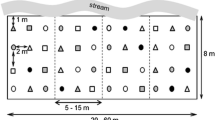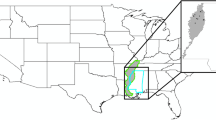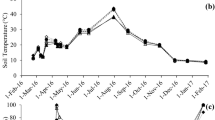Abstract
The exotic saltcedar (Tamarix ramosissima) has become the dominant woody plant in many riparian systems in the southwestern United States. We evaluated the effects of saltcedar clearing and overbank river flooding on recruitment of cottonwood (Populus fremontii) and saltcedar vegetation in the Rio Grande floodplain of central New Mexico, USA in 1993 and 1994. Overbank flooding coincided with the natural river hydrograph. After two seasons of growth, cleared areas supported more 1993 cohort cotton-woods and saltcedar than uncleared controlled areas. There were no differences between cleared and uncleared areas for the 1994 cohort after one growing season. Although there was a 2-week difference in the date of peak river flows between 1993 and 1994, similar seedling densities of both species were recorded for both years. The descending limb of the 1993 hydrograph was more gradual than the 1994 hydrograph, however, resulting in a higher survival rate of 1993 seedlings. Soil texture, soil salinity, elevation, and soil moisture data were collected from all plots and compared with seedling densities for each seedling sample date. Elevation and soil moisture indices were the most influential variables on seedling density. Decreasing soil moisture variables resulted in consistent seedling mortality for all species in cleared and uncleared plots for both cohorts. Secondary channels developed as a result of vegetative clearing where natural river fluvial processes provided topographic relief and sediment deposition for seedling establishment. Greater densities of cottonwoods and coyote willows (Salix exigua) were found on these deposits compared with remaining portions of cleared plots. Saltcedar clearing in conjunction with peak river flows in late May or early June encourages recruitment of native riparian plants, particularly along sand deposits created as a result of secondary channel development. Receding flows correlated with a receding water-table level of about 2 cm/day enhances native seedling densities relative to saltcedar.
Similar content being viewed by others
Literature Cited
Anderson, B. W. 1989. Research as an integral part of revegetation projects. p. 413–419.In Proceedings of the California Riparian Systems Conference, Berkley, CA, USA.
Blom, C. W. P. M. and L. A. J. C. Voesenek. 1996. Flooding: the survival strategies of plants. Tree 11:290–295.
Brady, N. C. 1974. Determination of soil class. p. 48–49.In The Nature and Properties of Soils. MacMillan Publishing Company, Inc., New York, NY, USA.
Bullard, T. F. and S. G. Wells. 1992. Hydrology of the Middle Rio Grande from Velarde to Elephant Butte Reservoir, New Mexico. U.S. Fish and Wildlife Service, Washington, DC, USA. Resource Publication 179.
Burnham, K. P., D. R. Anderson, and J. L. Laake. 1980. Estimation of density from line transect sampling of biological populations. Wildlife Monograph 72.
Crawford, C. S., A. C. Cully, R. Loutheuser, M. S. Sifuentes, L. H. White, and J. P. Wilber. 1993. Middle Rio Grande ecosystem: bosque biological management plan. U.S. Fish and Wildlife Service, Albuquerque, NM, USA.
Fenner, P., W. W. Brady, and D. R. Patton. 1984. Observations on seeds and seedlings of Fremont cottonwood. Desert Plants 6:55–58.
Fenner, P., W. W. Brady, and D. R. Patton. 1985. Effects of regulated water flows on regeneration of Fremont cottonwood. Journal of Range Management 38:135–138.
Gee, G. W. and J. W. Bauder. 1986. Particle size analysis. p. 383–412.In A. Klute (ed.) Methods of Soil Analysis, Part 1. Physical and Mineralogical Methods Second Edition. American Society of Agronomy, Madison, WI, USA.
Gill, J. 1978. Design and Analysis of Experiments in Animal and Medical Sciences, vol. 2. Iowa State University Press, Ames, IA, USA.
Graf, W. L. 1978. Fluvial adjustments to the spread of tamarisk in the Colorado Plateau region. Geological Society of America Bulletin 89:1491–1501.
Hartley, H. O. 1950. The maximum f-ratio as a short-cut test for heterogeneity of variances. Biometrika 37:308–312.
Hendrickx, J. M. H., B. Baerends, Z. I. Raza, M. Sadig, and A. Chaudhry. 1992. Soil salinity by electromagnetic induction of irrigated land. Soil Science Society of America Journal 56:1933–1941.
Hink, V. C. and R. D. Ohmart. 1984. Middle Rio Grande biological survey. U.S. Army Corps of Engineers. Albuquerque, NM, USA.
Hochberg, Y. and A. C. Tamhane. 1987. Multiple Comparison Procedures. John Wiley and Sons, New York, NY, USA.
Horton, J. S. 1960. Use of a root plow in clearing tamarisk stands. U.S. Department of Agriculture, Rocky Mountain Forest and Range Experiment Station, Ft. Collins, CO, USA. Research Note 50.
Horton, J. S. 1977. The development and perpetuation of the permanent tamarisk type in the phreatophyte zone of the southwest. U. S. Department of Agriculture, U. S. Forest Service General Technical Report RM 43:124–127.
Horton, J. S., F. C. Mounts, and J. M. Kraft. 1960. Seed germination and seedling establishment of phreatophyte species. U.S. Department of Agriculture, Rocky Mountain Forest and Range Experiment Station, Ft. Collins, CO, USA. Paper No. 48.
Howe, W. H. and F. L. Knopf 1991. On the imminent decline of Rio Grande cottonwoods in central New Mexico. Southwestern Naturalist 36:218–224.
Johnson, W. C., R. L. Burgess, and W. R. Keammerer. 1976. Forest overstory vegetation and environment on the Missouri River floodplain in North Dakota. Ecological Monographs 46:59–84.
Kirk, R. 1982. Experimental Design Procedures for Behavior Sciences, 2nd ed. Brooks/Cole Publishing Company, Belmont, CA, USA.
Knighton, D. 1984. Fluvial Forms and Processes. Edward Arnold Publishers, Ltd. Baltimore, MD, USA.
Mahoney, J. M. and S. B. Rood. 1991a. A device for studying the influence of declining water table on poplar growth and survival. Tree Physiology 8:305–314.
Mahoney, J. M. and S. B. Rood. 1991b. A model for assessing the effects of altered river flows on the recruitment of riparian cottonwoods. p. 228–232.In S. B. Rood and J. M. Mahoney, (eds.) The Biology and Management of Southern Alberta’s Cottonwoods. University of Lethbridge, Lethbridge, Alberta, Canada.
Mahoney, J. M. and S. B. Rood. 1992. Response of a hybrid poplar to water table decline in different substrates. Forest Ecology and Management 54:141–156.
Mauchley, J. W. 1940. Significance test for sphericity of a normal n-variate distribution. Annals of Mathematical Statistics 11:204–209.
Robinson, T. W. 1965. Introduction, spread, and area extent of salt cedar (Tamarix) in the western states. U.S. Geological Survey Professional Paper 491-A.
Scott, M. L., M. A. Wondzell, and G. T. Auble. 1993. Hydrograph characteristics relevant to the establishment and growth of western riparian vegetation. p. 237–246.In H. J. Morel-Seytoux. (ed.) Annual American Geophysical Union Hydrology Days. Hydrology Days Publications, Atherton, CA, USA.
Shafroth, P. B., J. M. Friedman, and L. S. Ischinger. 1995. Effects of salinity on establishment ofPopulus fremontii (cottonwood) andTamarix ramosissima (saltcedar) in southwestern United States. Great Basin Naturalist 55:58–65.
Shapiro, S. S. and M. B. Wilk. 1965. An analysis of variance test for normality (complete samples). Bometrika 52:591–611.
Sheets, K. R., J. P. Taylor, and J. M. H. Hendrickx. 1994. Rapid salinity mapping by electromagnetic induction for determining riparian restoration potential. Restoration Ecology 2:242–246.
Siegel, R. S. and J. H. Brock. 1990. Germination requirements of key southwestern woody riparian species. Desert Plants 10:3–8.
Szaro, R. C. 1989. Riparian forest and scrubland community types of Arizona and New Mexico. Desert Plants 9:69–139.
U.S. Bureau of Reclamation. 1992. Reclamation’s strategic plan. U. S. Department of the Interior. Bureau of Reclamation. Washington, DC, USA.
U. S. Bureau of Reclaination. 1993. Albuquerque projects office annual operating plan. U. S. Department of the Interior, Bureau of Reclamation. Albuquerque, NM, USA.
U. S. Bureau of Reclamation. 1994. Report to the Rio Grande compact commission. U. S. Department of the Interior. Bureau of Reclamation. Albuquerque, NM, USA.
Werner, P. A. 1979. Competition and coexistence of similar species. p. 287–310.in O. T. Solbrig, S. Jain, G. B. Johnson, and P. H. Raven, (eds.) Topics in Plant Population Biology. Columbia University Press, New York, NY, USA.
Author information
Authors and Affiliations
Rights and permissions
About this article
Cite this article
Taylor, J.P., Wester, D.B. & Smith, L.M. Soil disturbance, flood management, and riparian woody plant establishment in the Rio Grande floodplain. Wetlands 19, 372–382 (1999). https://doi.org/10.1007/BF03161769
Received:
Revised:
Accepted:
Issue Date:
DOI: https://doi.org/10.1007/BF03161769




